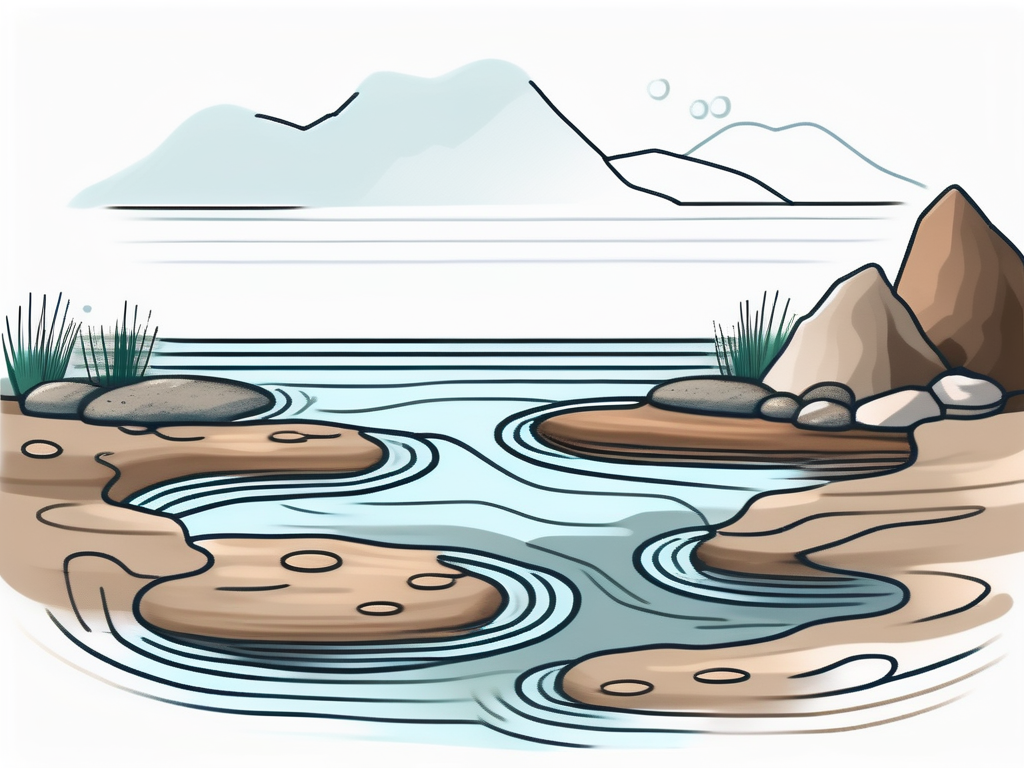
Vadose Zone: Wastewater Treatment Explained
The vadose zone, also known as the unsaturated zone, is a crucial component of the earth's subsurface environment that exists between the land surface and the underlying aquifer. This zone plays a significant role in wastewater treatment, acting as a natural filter for pollutants and contaminants. Understanding the vadose zone's function and characteristics is essential for effective wastewater management and environmental protection.
Wastewater treatment is a complex process designed to remove contaminants and pollutants from water to make it safe for discharge or reuse. The vadose zone's role in this process is often overlooked, but it is a critical component of the natural wastewater treatment system. This article will delve into the intricacies of the vadose zone and its role in wastewater treatment, providing a comprehensive understanding of this important environmental feature.
Understanding the Vadose Zone
The vadose zone is the region between the earth's surface and the water table, where the pores in the soil or rock are not fully saturated with water. The moisture content in this zone can vary greatly, from completely dry to nearly saturated, depending on factors such as rainfall, evaporation, and the characteristics of the soil or rock.
Despite its variability, the vadose zone plays a crucial role in the hydrological cycle, acting as a conduit for water movement from the surface to the underlying aquifer. It also serves as a natural filter, trapping and breaking down many types of pollutants that can contaminate groundwater resources.
Characteristics of the Vadose Zone
The vadose zone's characteristics can vary greatly depending on the type of soil or rock, the climate, and other environmental factors. These characteristics can significantly affect the zone's ability to filter pollutants and its overall role in wastewater treatment.
For example, the vadose zone's permeability, or its ability to transmit water, can greatly affect how quickly wastewater moves through the zone and reaches the underlying aquifer. A highly permeable vadose zone can allow wastewater to move quickly, potentially bypassing the natural filtration process and leading to groundwater contamination.
Role of the Vadose Zone in the Hydrological Cycle
The vadose zone plays a critical role in the hydrological cycle, acting as a conduit for water movement from the surface to the underlying aquifer. This process, known as recharge, is essential for maintaining groundwater levels and ensuring a sustainable water supply.
However, the vadose zone's role in the hydrological cycle also makes it a potential pathway for pollutants to reach the aquifer. This is particularly true in areas where wastewater is discharged onto the land surface, such as in septic systems or land-based wastewater treatment systems.
Vadose Zone in Wastewater Treatment
The vadose zone's role in wastewater treatment is often overlooked, but it is a critical component of the natural wastewater treatment system. As wastewater percolates through the vadose zone, it undergoes a series of physical, chemical, and biological processes that can remove or break down many types of pollutants.
These processes, collectively known as soil aquifer treatment (SAT), can be highly effective at treating wastewater, particularly for removing organic matter, nutrients, and pathogens. However, the effectiveness of SAT can vary greatly depending on the characteristics of the vadose zone and the type of pollutants in the wastewater.
Physical Processes in the Vadose Zone
Physical processes in the vadose zone include filtration and adsorption. Filtration is the process where solid particles in the wastewater are trapped by the soil or rock in the vadose zone. This can include larger pollutants, such as sediment or organic matter, as well as smaller particles, such as bacteria or viruses.
Adsorption is the process where pollutants in the wastewater adhere to the surface of the soil or rock particles in the vadose zone. This can be particularly effective for removing certain types of pollutants, such as heavy metals or organic compounds, that can bind strongly to the soil or rock surfaces.
Chemical Processes in the Vadose Zone
Chemical processes in the vadose zone include ion exchange, precipitation, and oxidation-reduction reactions. Ion exchange is the process where pollutants in the wastewater exchange places with ions on the surface of the soil or rock particles in the vadose zone. This can be particularly effective for removing certain types of pollutants, such as heavy metals or nutrients, that can bind strongly to the soil or rock surfaces.
Precipitation is the process where pollutants in the wastewater react with other substances in the vadose zone to form solid particles that can be trapped by the soil or rock. This can be particularly effective for removing certain types of pollutants, such as phosphorus or certain heavy metals, that can form insoluble compounds.
Biological Processes in the Vadose Zone
Biological processes in the vadose zone include microbial degradation and nutrient cycling. Microbial degradation is the process where microorganisms in the vadose zone break down organic matter and other pollutants in the wastewater. This can be particularly effective for removing organic pollutants, such as petroleum hydrocarbons or pesticides, that can be degraded by microorganisms.
Nutrient cycling is the process where microorganisms in the vadose zone convert nutrients in the wastewater into different forms. This can include the conversion of nitrogen in the wastewater from ammonia or nitrate, which can be harmful to aquatic ecosystems, into nitrogen gas, which is harmless and can be released into the atmosphere.
Factors Affecting Vadose Zone Treatment
Several factors can affect the vadose zone's ability to treat wastewater, including the characteristics of the vadose zone, the type of pollutants in the wastewater, and the volume and rate of wastewater application. Understanding these factors is essential for optimizing the use of the vadose zone in wastewater treatment and preventing groundwater contamination.
The characteristics of the vadose zone, such as its depth, permeability, and microbial activity, can greatly affect its ability to treat wastewater. For example, a deep, highly permeable vadose zone with high microbial activity can provide effective treatment for a wide range of pollutants. However, a shallow, low-permeability vadose zone with low microbial activity may not be able to effectively treat the wastewater and could lead to groundwater contamination.
Type of Pollutants
The type of pollutants in the wastewater can also affect the vadose zone's ability to treat the wastewater. Some pollutants, such as organic matter and nutrients, can be effectively removed or broken down by the vadose zone. However, other pollutants, such as certain heavy metals or synthetic organic compounds, may not be effectively removed and could potentially contaminate the underlying aquifer.
Furthermore, the presence of certain pollutants can inhibit the vadose zone's ability to treat other pollutants. For example, high concentrations of salts in the wastewater can inhibit microbial activity in the vadose zone, reducing its ability to break down organic matter and other pollutants.
Volume and Rate of Wastewater Application
The volume and rate of wastewater application can also affect the vadose zone's ability to treat the wastewater. Applying too much wastewater too quickly can overwhelm the vadose zone's capacity to treat the wastewater, leading to incomplete treatment and potential groundwater contamination.
On the other hand, applying too little wastewater or applying it too slowly can also lead to problems. For example, if the vadose zone becomes too dry, microbial activity can decrease, reducing the vadose zone's ability to break down organic matter and other pollutants.
Monitoring and Management of the Vadose Zone
Monitoring and management of the vadose zone are essential for ensuring its effective use in wastewater treatment and preventing groundwater contamination. This can include monitoring the vadose zone's moisture content and pollutant concentrations, as well as managing the volume and rate of wastewater application.

Effective monitoring and management of the vadose zone require a thorough understanding of the vadose zone's characteristics and the factors affecting its ability to treat wastewater. This can be achieved through regular monitoring of the vadose zone and the wastewater, as well as through the use of models to predict the vadose zone's behavior under different conditions.
Monitoring Techniques
Several techniques can be used to monitor the vadose zone, including soil moisture sensors, lysimeters, and groundwater monitoring wells. Soil moisture sensors can provide real-time information on the vadose zone's moisture content, which can be used to manage the volume and rate of wastewater application.
Lysimeters and groundwater monitoring wells can be used to collect samples from the vadose zone and the underlying aquifer, which can be analyzed for pollutant concentrations. This can provide information on the vadose zone's effectiveness in treating the wastewater and any potential groundwater contamination.
Management Strategies
Several strategies can be used to manage the vadose zone for wastewater treatment, including adjusting the volume and rate of wastewater application, adding amendments to the vadose zone to enhance its treatment capacity, and rotating the areas where wastewater is applied.
Adjusting the volume and rate of wastewater application can help to optimize the vadose zone's treatment capacity and prevent overloading. Adding amendments, such as organic matter or certain types of clay, can enhance the vadose zone's ability to adsorb pollutants and increase its microbial activity. Rotating the areas where wastewater is applied can help to prevent the vadose zone from becoming overloaded or exhausted, ensuring its long-term effectiveness in treating wastewater.
Conclusion
The vadose zone plays a crucial role in wastewater treatment, acting as a natural filter for pollutants and contaminants. Understanding its function and characteristics is essential for effective wastewater management and environmental protection. With proper monitoring and management, the vadose zone can provide effective, sustainable wastewater treatment, protecting our precious groundwater resources.

However, the vadose zone's role in wastewater treatment is complex and can be affected by many factors. Ongoing research is needed to better understand these factors and to develop more effective strategies for using the vadose zone in wastewater treatment. By doing so, we can ensure the sustainable use of our water resources and the protection of our environment for future generations.



